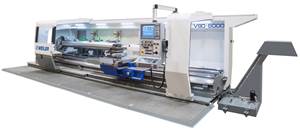Reducing Machine Cycle Times Both In and Out of the Cut
Increasing automation means setup times are lower than ever. How can shops optimize cycle times to match and win more business?
Welcome to the first monthly installment of Miller’s Edge, a new Modern Machine Shop column. Each month, John Miller, owner of Way of the Mill CNC training and consulting, will use his machining expertise to answer a reader-submitted question. Submit your question here!
Reader Question
“Thanks to automation, we’ve moved toward higher volumes after years of mostly small batch work. Setup time used to be the bigger concern, but we are now focusing on cycle time more than ever. How do you suggest we approach cycle time reduction?”

Non-cut cycle time reductions are less likely to affect the final part quality — as such, focus on these improvements before altering segments of a program where the tool is touching the part. Photo credit: Way of the Mill
Miller’s Answer
As problems go, this is a good one to have — it means you’re growing as a shop! Before digging into specifics, however, take care that you’re performing quality audits alongside all cycle time reduction efforts. If your cycle time reductions cause a proportionate increase in scrap, you’ve netted zero improvements.
Following four baseline rules can help maintain your quality level. First, keep quality as the foremost goal. The process must satisfy the part print before getting faster. Second, check that you’re actually facing a cycle time issue, and that inefficiencies aren’t creeping in from outside the machine. Third, concentrate on easy, low-risk, high-impact changes, as implementing these should be quick and provide immediate returns. Lastly, have a target in mind — know when enough is enough.
Cycle time reductions come in two primary forms: non-cut time reductions and cut time reductions. Non-cut time reductions decrease the amount of time the cutter is not touching the part. These reductions do not carry risk to part quality themselves, but do carry some risk as rapid movements become more aggressive. Cut time reductions decrease the amount of time the cutter is touching metal and can potentially have large impacts on quality.
For non-cut time reductions, the goal is to remove any pauses or wasted machine motion in the process. Pauses are any hiccups or stops in the program, other than purposeful dwells. To eliminate pauses, watch your process run, document the occurrences and tackle them one by one. The most common pauses stem from missed tool pre-calls. Wasted motion is excessive movement around the part, such as positioning the rotary axes independent of X and Y. If Z is safe, move them all together.
To their credit, machine manufacturers have done a lot for non-cut time improvements. The three most common improvements across all machine platforms are fourth- and fifth-axis rotary positioning during tool change, axis movement in parallel with spindle ramp up and axis retraction in concert with commands to turn off coolant or open the shutter door. Be sure to consult with your manufacturer on whether your machine has similar functions, and how to best implement them.
In general, non-cut time reductions only require small program edits and a quick safety check, but they can have a big impact on the final cycle time. These edits are also free, require no new tooling and come at no risk to part quality.
Cut time reductions are riskier. The best way to mitigate these risks is to take a progressive approach, recognizing the risks at each step and taking the time to confirm quality along the way.
First, document the cycle time of each tool in the process. Focus reduction efforts on tools that run longer, as a small, low-risk improvement on a long process may result in a larger overall improvement versus a high-risk change to a short process.
After identifying the longer-running tools, assess what type of process they’re used with and how a change would impact final part quality. In roughing tool paths that don’t touch a finish surface, increasing speeds and feeds could lead to higher cutting forces that move the part, cause tapered surfaces or impact finishing processes through leftover material. For finishing tool paths that are the last to touch a particular feature, increasing speeds and feeds may impact dimensions of size or form, increase wear or change surface finishes. No matter what the process, however, keep harmonics, spindle power, torque and tool life in mind when increasing speeds and feeds.
Given the quality risk, you should carry out only one change at a time and confirm quality before implementing the next change. Altering too much at one time can compound issues and make troubleshooting nearly impossible. Be sure to document all changes carefully throughout in case you need to revert to the last known good solution.
When diving into any cycle time reduction effort, I always recommend starting with non-cut time reductions before turning to cut time reductions. There is always the possibility that, even after all these improvements, the reductions just aren’t enough to meet production demands. This is the time to consider investment into new tools, maybe even new machine platforms. However, a focus on optimizing what you have first is always the best approach. The optimizations may reach your goals, and you may realize new potential in your existing technologies.
Related Content
Modern Bar Feeds Bring New Life to Automatic Swiss Lathes
Cam-actuated Swiss lathes are still the fastest way to process many parts. By adding modern bar feeders, this shop has dramatically improved their utilization with the ability to work unattended, even in a lights-out environment.
Read MorePartial Automation Inspires Full Cobot Overhaul
Targeting two-to-four hours of nightly automation enables high-mix manufacturer Wagner Machine to radically boost its productivity past a single shift.
Read MoreWeiler to Debut New Automation Features For Its Lathes
Weiler’s V 110 four-way precision lathe introduces features new to the U.S.
Read MoreLean Approach to Automated Machine Tending Delivers Quicker Paths to Success
Almost any shop can automate at least some of its production, even in low-volume, high-mix applications. The key to getting started is finding the simplest solutions that fit your requirements. It helps to work with an automation partner that understands your needs.
Read MoreRead Next
Obscure CNC Features That Can Help (or Hurt) You
You cannot begin to take advantage of an available feature if you do not know it exists. Conversely, you will not know how to avoid CNC features that may be detrimental to your process.
Read More3 Mistakes That Cause CNC Programs to Fail
Despite enhancements to manufacturing technology, there are still issues today that can cause programs to fail. These failures can cause lost time, scrapped parts, damaged machines and even injured operators.
Read MoreThe Cut Scene: The Finer Details of Large-Format Machining
Small details and features can have an outsized impact on large parts, such as Barbco’s collapsible utility drill head.
Read More

















.png;maxWidth=300;quality=90)







